University of Roehampton: BAS & Promotional Focus Correlation
VerifiedAdded on 2023/06/14
|16
|3425
|370
Report
AI Summary
This report investigates the relationship between the behavioral activation system (BAS) and promotional self-regulation focus, drawing on Jeffrey Alan Gray's biopsychological theory and Higgins' regulatory focus theory. The study, conducted with 145 undergraduate psychology students at the University of Roehampton, explored whether BAS scores (drive, reward responsiveness, and fun-seeking) correlate with promotional focus scores. The results indicated no significant correlation between BAS scores and promotional self-regulation focus, leading to the acceptance of the null hypothesis. A linear regression model further confirmed the lack of predictive power of BAS scores on promotional focus. The study acknowledges limitations such as a gender imbalance and a small, homogeneous sample, suggesting future research with a more diverse population is needed. Desklib provides access to similar reports and study tools for students.

P a g e | 1
Effect of behavioral activation system
and promotional regulatory focus
Word Count: 1689
Abstract
Behavioral orientation in psychology was found to be connected to two
factors of promotion and pain. Earlier studies established significant correlation
between factors of self-regulation to those of motivational approaches. The inter
correlation between the behavioral activation system and promotional self-
regulation focus was studied with 145 participants. The assumed hypothesis of un-
correlation between independent variables of behavioral activation scores and
dependent variable of self-regulation focus score was established to be true in the
study. The outcome of the study was inconclusive in nature due to limitation of the
sample.
Effect of behavioral activation system
and promotional regulatory focus
Word Count: 1689
Abstract
Behavioral orientation in psychology was found to be connected to two
factors of promotion and pain. Earlier studies established significant correlation
between factors of self-regulation to those of motivational approaches. The inter
correlation between the behavioral activation system and promotional self-
regulation focus was studied with 145 participants. The assumed hypothesis of un-
correlation between independent variables of behavioral activation scores and
dependent variable of self-regulation focus score was established to be true in the
study. The outcome of the study was inconclusive in nature due to limitation of the
sample.
Paraphrase This Document
Need a fresh take? Get an instant paraphrase of this document with our AI Paraphraser
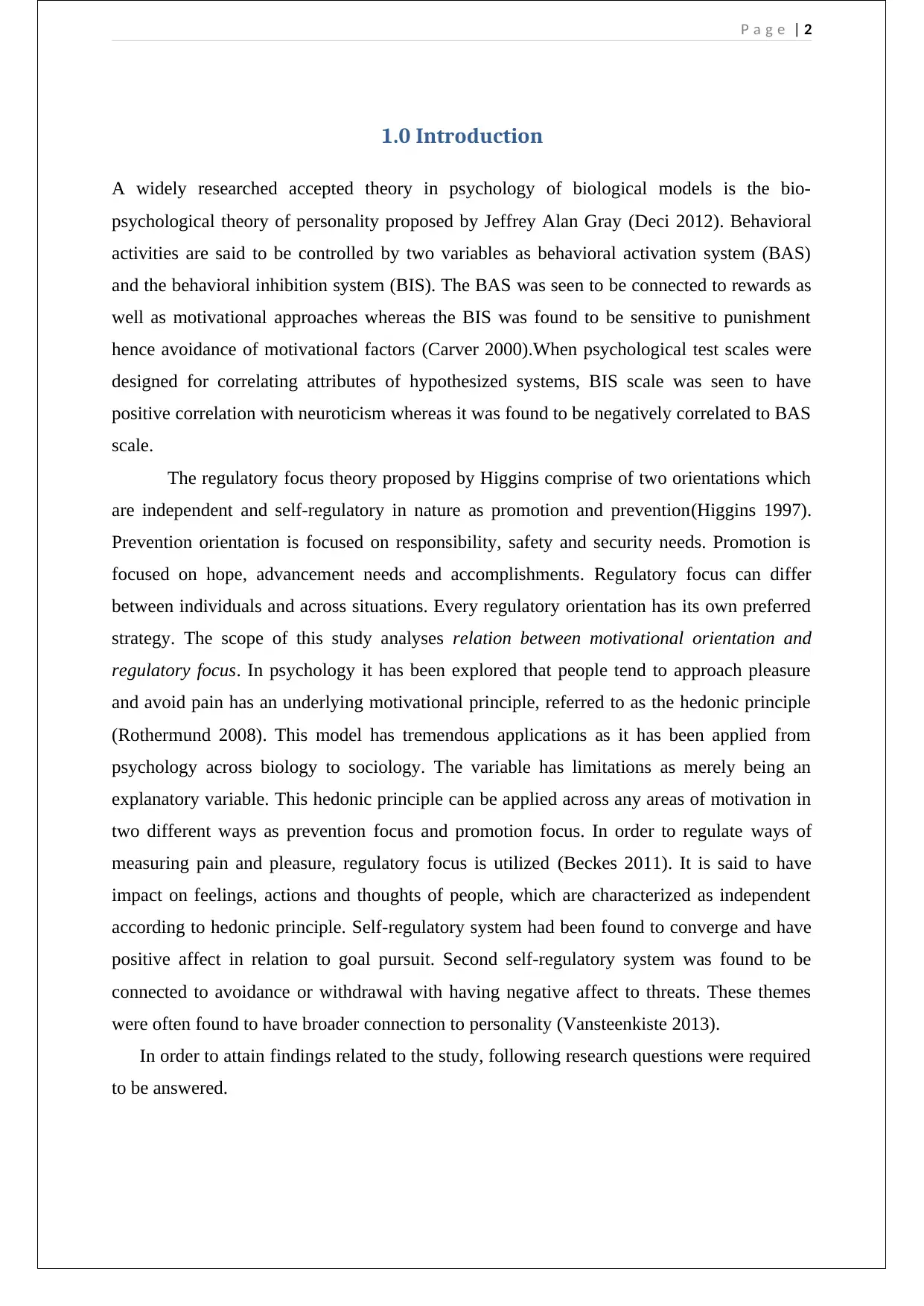
P a g e | 2
1.0 Introduction
A widely researched accepted theory in psychology of biological models is the bio-
psychological theory of personality proposed by Jeffrey Alan Gray (Deci 2012). Behavioral
activities are said to be controlled by two variables as behavioral activation system (BAS)
and the behavioral inhibition system (BIS). The BAS was seen to be connected to rewards as
well as motivational approaches whereas the BIS was found to be sensitive to punishment
hence avoidance of motivational factors (Carver 2000).When psychological test scales were
designed for correlating attributes of hypothesized systems, BIS scale was seen to have
positive correlation with neuroticism whereas it was found to be negatively correlated to BAS
scale.
The regulatory focus theory proposed by Higgins comprise of two orientations which
are independent and self-regulatory in nature as promotion and prevention(Higgins 1997).
Prevention orientation is focused on responsibility, safety and security needs. Promotion is
focused on hope, advancement needs and accomplishments. Regulatory focus can differ
between individuals and across situations. Every regulatory orientation has its own preferred
strategy. The scope of this study analyses relation between motivational orientation and
regulatory focus. In psychology it has been explored that people tend to approach pleasure
and avoid pain has an underlying motivational principle, referred to as the hedonic principle
(Rothermund 2008). This model has tremendous applications as it has been applied from
psychology across biology to sociology. The variable has limitations as merely being an
explanatory variable. This hedonic principle can be applied across any areas of motivation in
two different ways as prevention focus and promotion focus. In order to regulate ways of
measuring pain and pleasure, regulatory focus is utilized (Beckes 2011). It is said to have
impact on feelings, actions and thoughts of people, which are characterized as independent
according to hedonic principle. Self-regulatory system had been found to converge and have
positive affect in relation to goal pursuit. Second self-regulatory system was found to be
connected to avoidance or withdrawal with having negative affect to threats. These themes
were often found to have broader connection to personality (Vansteenkiste 2013).
In order to attain findings related to the study, following research questions were required
to be answered.
1.0 Introduction
A widely researched accepted theory in psychology of biological models is the bio-
psychological theory of personality proposed by Jeffrey Alan Gray (Deci 2012). Behavioral
activities are said to be controlled by two variables as behavioral activation system (BAS)
and the behavioral inhibition system (BIS). The BAS was seen to be connected to rewards as
well as motivational approaches whereas the BIS was found to be sensitive to punishment
hence avoidance of motivational factors (Carver 2000).When psychological test scales were
designed for correlating attributes of hypothesized systems, BIS scale was seen to have
positive correlation with neuroticism whereas it was found to be negatively correlated to BAS
scale.
The regulatory focus theory proposed by Higgins comprise of two orientations which
are independent and self-regulatory in nature as promotion and prevention(Higgins 1997).
Prevention orientation is focused on responsibility, safety and security needs. Promotion is
focused on hope, advancement needs and accomplishments. Regulatory focus can differ
between individuals and across situations. Every regulatory orientation has its own preferred
strategy. The scope of this study analyses relation between motivational orientation and
regulatory focus. In psychology it has been explored that people tend to approach pleasure
and avoid pain has an underlying motivational principle, referred to as the hedonic principle
(Rothermund 2008). This model has tremendous applications as it has been applied from
psychology across biology to sociology. The variable has limitations as merely being an
explanatory variable. This hedonic principle can be applied across any areas of motivation in
two different ways as prevention focus and promotion focus. In order to regulate ways of
measuring pain and pleasure, regulatory focus is utilized (Beckes 2011). It is said to have
impact on feelings, actions and thoughts of people, which are characterized as independent
according to hedonic principle. Self-regulatory system had been found to converge and have
positive affect in relation to goal pursuit. Second self-regulatory system was found to be
connected to avoidance or withdrawal with having negative affect to threats. These themes
were often found to have broader connection to personality (Vansteenkiste 2013).
In order to attain findings related to the study, following research questions were required
to be answered.
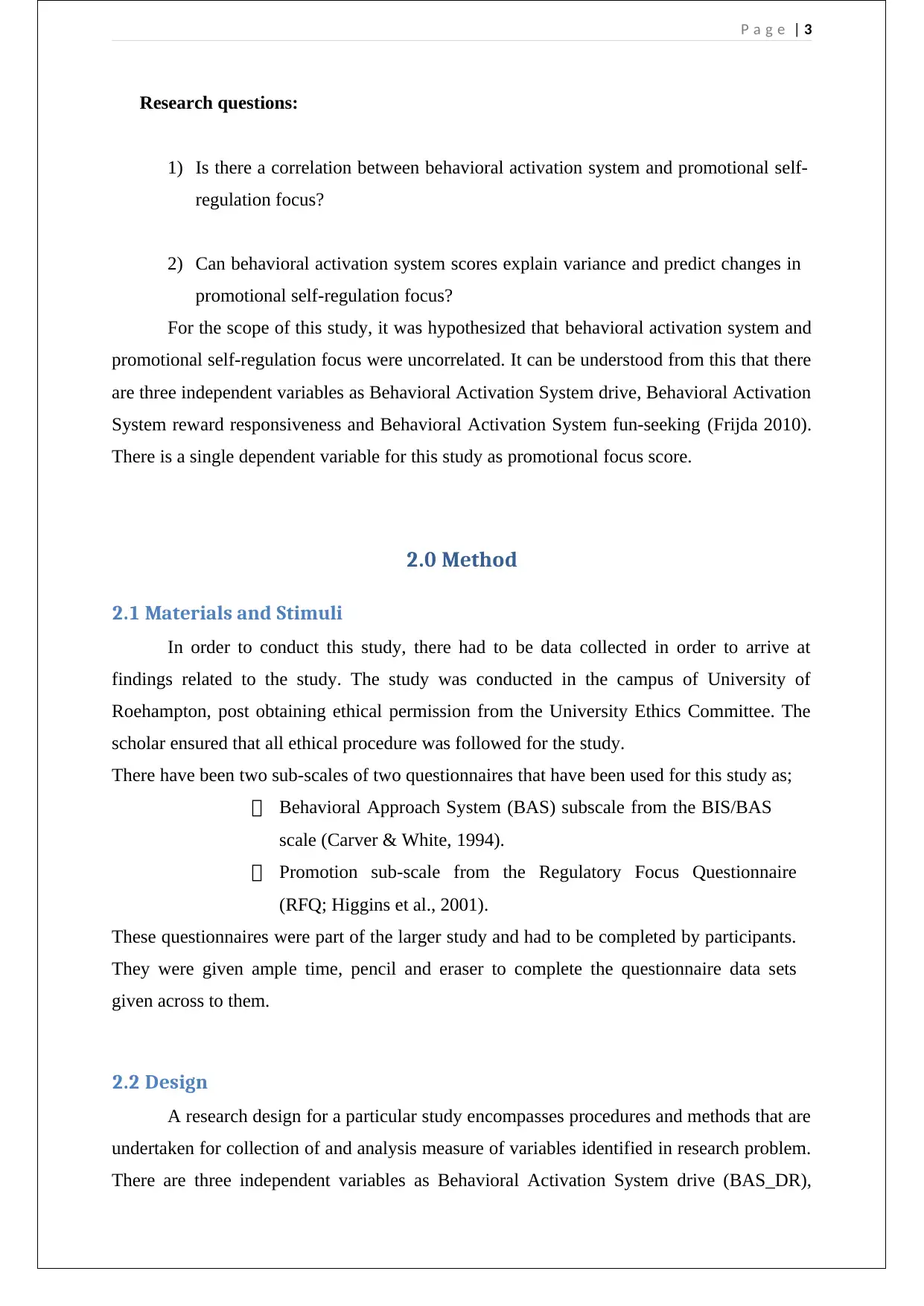
P a g e | 3
Research questions:
1) Is there a correlation between behavioral activation system and promotional self-
regulation focus?
2) Can behavioral activation system scores explain variance and predict changes in
promotional self-regulation focus?
For the scope of this study, it was hypothesized that behavioral activation system and
promotional self-regulation focus were uncorrelated. It can be understood from this that there
are three independent variables as Behavioral Activation System drive, Behavioral Activation
System reward responsiveness and Behavioral Activation System fun-seeking (Frijda 2010).
There is a single dependent variable for this study as promotional focus score.
2.0 Method
2.1 Materials and Stimuli
In order to conduct this study, there had to be data collected in order to arrive at
findings related to the study. The study was conducted in the campus of University of
Roehampton, post obtaining ethical permission from the University Ethics Committee. The
scholar ensured that all ethical procedure was followed for the study.
There have been two sub-scales of two questionnaires that have been used for this study as;
Behavioral Approach System (BAS) subscale from the BIS/BAS
scale (Carver & White, 1994).
Promotion sub-scale from the Regulatory Focus Questionnaire
(RFQ; Higgins et al., 2001).
These questionnaires were part of the larger study and had to be completed by participants.
They were given ample time, pencil and eraser to complete the questionnaire data sets
given across to them.
2.2 Design
A research design for a particular study encompasses procedures and methods that are
undertaken for collection of and analysis measure of variables identified in research problem.
There are three independent variables as Behavioral Activation System drive (BAS_DR),
Research questions:
1) Is there a correlation between behavioral activation system and promotional self-
regulation focus?
2) Can behavioral activation system scores explain variance and predict changes in
promotional self-regulation focus?
For the scope of this study, it was hypothesized that behavioral activation system and
promotional self-regulation focus were uncorrelated. It can be understood from this that there
are three independent variables as Behavioral Activation System drive, Behavioral Activation
System reward responsiveness and Behavioral Activation System fun-seeking (Frijda 2010).
There is a single dependent variable for this study as promotional focus score.
2.0 Method
2.1 Materials and Stimuli
In order to conduct this study, there had to be data collected in order to arrive at
findings related to the study. The study was conducted in the campus of University of
Roehampton, post obtaining ethical permission from the University Ethics Committee. The
scholar ensured that all ethical procedure was followed for the study.
There have been two sub-scales of two questionnaires that have been used for this study as;
Behavioral Approach System (BAS) subscale from the BIS/BAS
scale (Carver & White, 1994).
Promotion sub-scale from the Regulatory Focus Questionnaire
(RFQ; Higgins et al., 2001).
These questionnaires were part of the larger study and had to be completed by participants.
They were given ample time, pencil and eraser to complete the questionnaire data sets
given across to them.
2.2 Design
A research design for a particular study encompasses procedures and methods that are
undertaken for collection of and analysis measure of variables identified in research problem.
There are three independent variables as Behavioral Activation System drive (BAS_DR),
⊘ This is a preview!⊘
Do you want full access?
Subscribe today to unlock all pages.

Trusted by 1+ million students worldwide

P a g e | 4
Behavioral Activation System reward responsiveness (BAS RR) and Behavioral Activation
System fun-seeking (BAS_FS). There is a single dependent variable for this study as
promotional focus score. Post collection of data from 145 participants for the study and then
correlation and simple linear regression has been conducted on it. The outcome variable for
this study is promotional self-regulation focus score (RTF). Post collection of various BAS
category score RTF was measured.
2.3Participants
Data was collected from first year undergraduate psychology students at the
University of Roehampton. One fine morning University students was approach with the
aims and goals related to the study. A comprehensive workshop was conducted with the
University students. This workshop highlighted the way bouts of participating and
progressing in this research. Participants’ mean age for the study was 20.94 years with
skewness of 3.54 and kurtosis of 12.82. Males in the study were 22 and female participants
were 123. Research procedure and ways to calculate scores related to BIS and BAS was
taught to them. Once all procedures had been told to them many withdrew and indicated
their disinterest to participate in the study. Amongst remaining participants only 145
students finally participated in the research procedure. The participants for the study were
handed over the questionnaire for the research. Participants were not naïve regarding the
aims of the research as they were students of psychology departments. Participants were
given certificates for participating in the study procedure.
3.0 Procedure
Participants were made to follow step by step procedure for undertaking part in the
study. The participants were asked to attend a workshop to get details regarding research
aims. They were briefed about the techniques to calculate scores. Participant were given
participation form and asked to put their signature to indicate consent for taking part in the
study. The questionnaire was distributed to the participants and they were asked to answer the
multiple choice questions by using pencil. After completion of the answering session scores
related to BAS and RTF were calculated by the scholar. The results of the test were finalized
after a week of study.
Behavioral Activation System reward responsiveness (BAS RR) and Behavioral Activation
System fun-seeking (BAS_FS). There is a single dependent variable for this study as
promotional focus score. Post collection of data from 145 participants for the study and then
correlation and simple linear regression has been conducted on it. The outcome variable for
this study is promotional self-regulation focus score (RTF). Post collection of various BAS
category score RTF was measured.
2.3Participants
Data was collected from first year undergraduate psychology students at the
University of Roehampton. One fine morning University students was approach with the
aims and goals related to the study. A comprehensive workshop was conducted with the
University students. This workshop highlighted the way bouts of participating and
progressing in this research. Participants’ mean age for the study was 20.94 years with
skewness of 3.54 and kurtosis of 12.82. Males in the study were 22 and female participants
were 123. Research procedure and ways to calculate scores related to BIS and BAS was
taught to them. Once all procedures had been told to them many withdrew and indicated
their disinterest to participate in the study. Amongst remaining participants only 145
students finally participated in the research procedure. The participants for the study were
handed over the questionnaire for the research. Participants were not naïve regarding the
aims of the research as they were students of psychology departments. Participants were
given certificates for participating in the study procedure.
3.0 Procedure
Participants were made to follow step by step procedure for undertaking part in the
study. The participants were asked to attend a workshop to get details regarding research
aims. They were briefed about the techniques to calculate scores. Participant were given
participation form and asked to put their signature to indicate consent for taking part in the
study. The questionnaire was distributed to the participants and they were asked to answer the
multiple choice questions by using pencil. After completion of the answering session scores
related to BAS and RTF were calculated by the scholar. The results of the test were finalized
after a week of study.
Paraphrase This Document
Need a fresh take? Get an instant paraphrase of this document with our AI Paraphraser

P a g e | 5
4.0 Results
The data of 145 participants were collected from the thirteen answers of behavioral
activation system (BAS) and six answers on promotional self-regulation focus. Three
measures, BAS Drive (BAS_DR), BAS Reward Responsiveness (BAS_RR) and BAS Fun
Seeking (BAS_FS) were measured (Carver & White, 1994) from the thirteen answers on
behavioral activation systems. The promotional self-regulation focus score (RTF) was
calculated (Higgins et al., 2001) from the six answers on regulation focus. Behavioral
activation systems scores were negatively skewed with skewness of -0.124 (BAS_DR), -
0.218 (BAS_RR) and -0.298 (BAS_FS). The kurtosis measures were 0.4 (BAS_DR), -0.27
(BAS_RR) and -0.39 (BAS_FS). It was claimed that the population distribution was non-
normal in nature and hence non-parametric, as interoperated from value of skewness and
kurtosis. Scattered diagrams were drawn to understand the relation between three
independent variables of BAS and the dependent RTF score(Ferguson 2008). Highly
scattered data in the scatter plots indicated that RTF score of the participants were
independent of all of the three BAS scores.
Figure 1: Relation between Regulation focus promotion and BAS Drive
4.0 Results
The data of 145 participants were collected from the thirteen answers of behavioral
activation system (BAS) and six answers on promotional self-regulation focus. Three
measures, BAS Drive (BAS_DR), BAS Reward Responsiveness (BAS_RR) and BAS Fun
Seeking (BAS_FS) were measured (Carver & White, 1994) from the thirteen answers on
behavioral activation systems. The promotional self-regulation focus score (RTF) was
calculated (Higgins et al., 2001) from the six answers on regulation focus. Behavioral
activation systems scores were negatively skewed with skewness of -0.124 (BAS_DR), -
0.218 (BAS_RR) and -0.298 (BAS_FS). The kurtosis measures were 0.4 (BAS_DR), -0.27
(BAS_RR) and -0.39 (BAS_FS). It was claimed that the population distribution was non-
normal in nature and hence non-parametric, as interoperated from value of skewness and
kurtosis. Scattered diagrams were drawn to understand the relation between three
independent variables of BAS and the dependent RTF score(Ferguson 2008). Highly
scattered data in the scatter plots indicated that RTF score of the participants were
independent of all of the three BAS scores.
Figure 1: Relation between Regulation focus promotion and BAS Drive

P a g e | 6
Figure 2: Relation between Regulation focus promotion and BAS Fun Seeking
Figure 3: Relation between Regulation focus promotion and BAS Reward Responsiveness
The mean behavioral activation scores for the participants were 2.71 for BAS drive
(S.D 0.57), 3 for BAS fun seeking (S.D 0.55) and 4.26 for BAS reward responsiveness (S.D
0.48). Mean for the dependent promotional self-regulation focus score was 3.24 with S.D
0.36.
Reliability measure (Cronbach alpha) of BAS drive, BAS_FS and BAS_RR were
0.78, 0.71 and 0.57 respectively. Hence the three scores were almost acceptable as measures
of behavioral activation scores. Pearson’s correlation coefficient between RTF score and
BAS Drive, BAS_RR and BAS_FS were -0.006, 0.102 and 0.049 (table 7 in appendix). The
correlation coefficient scores revealed that the BAS scores were uncorrelated with RTF score
and the significance values for all these correlations were greater than 0.05. The null
Figure 2: Relation between Regulation focus promotion and BAS Fun Seeking
Figure 3: Relation between Regulation focus promotion and BAS Reward Responsiveness
The mean behavioral activation scores for the participants were 2.71 for BAS drive
(S.D 0.57), 3 for BAS fun seeking (S.D 0.55) and 4.26 for BAS reward responsiveness (S.D
0.48). Mean for the dependent promotional self-regulation focus score was 3.24 with S.D
0.36.
Reliability measure (Cronbach alpha) of BAS drive, BAS_FS and BAS_RR were
0.78, 0.71 and 0.57 respectively. Hence the three scores were almost acceptable as measures
of behavioral activation scores. Pearson’s correlation coefficient between RTF score and
BAS Drive, BAS_RR and BAS_FS were -0.006, 0.102 and 0.049 (table 7 in appendix). The
correlation coefficient scores revealed that the BAS scores were uncorrelated with RTF score
and the significance values for all these correlations were greater than 0.05. The null
⊘ This is a preview!⊘
Do you want full access?
Subscribe today to unlock all pages.

Trusted by 1+ million students worldwide

P a g e | 7
hypothesis was readily accepted that promotional self-regulation focus was independent of
behavioral scores.
A linear regression model was constructed where the coefficients were -0.043, -0.018
and 0.089 for BAS drive, BAS_FS and BAS_RR. The significance values were 0.477, 0.776
and 0.218 for the three independent behavioral scores. The intercept was 2.928 with
significance value of zero. Hence RTF score was had a statistically poor linear relationship
with behavioral scores where the coefficients were statistically insignificant. The high
positive intercept indicated the RTF score was independent from the BAS scores. The
adjusted R square for the regression model was almost zero (-.007) and hence BAS scores
failed to explain the variance in promotional self-regulation.
5.0 Discussion
The main aim of the research work was to find existence of any correlation between
promotional self-regulation focus and behavioral activation system(Skinner 2009). The
study found that there behavioral activation system scores did not have an effect on the
promotional self-regulation for the participants. The collected data was also unable to
establish any explanation of variance in self-regulation for the participants. In an earlier
study by Ursache, Blair and Raver (2011) found that promotional self-regulation was
related to early achievements in children. Similar trends were also established earlier by
Schmeichel, Brandon J.,Harmon-Jones, Cindy,Harmon-Jones, Eddie (2010). The
researcher did not find any relevant correlation in support of the previous works. The
hedonic principle (Rothermund 2008) could not be supported in the research work.
The limitation lied in the fact the study was conducted with only first year students of
the university where most number of participants were females. The gender biasness
(figure 4-6 in appendix) and small population were two major reasons for un-correlative
nature of the results(Higgins 1998). There was scope for future study including all the
students of the university. Heterogeneous population with gender parity was required to
obtain normal population and for parametric tests.
hypothesis was readily accepted that promotional self-regulation focus was independent of
behavioral scores.
A linear regression model was constructed where the coefficients were -0.043, -0.018
and 0.089 for BAS drive, BAS_FS and BAS_RR. The significance values were 0.477, 0.776
and 0.218 for the three independent behavioral scores. The intercept was 2.928 with
significance value of zero. Hence RTF score was had a statistically poor linear relationship
with behavioral scores where the coefficients were statistically insignificant. The high
positive intercept indicated the RTF score was independent from the BAS scores. The
adjusted R square for the regression model was almost zero (-.007) and hence BAS scores
failed to explain the variance in promotional self-regulation.
5.0 Discussion
The main aim of the research work was to find existence of any correlation between
promotional self-regulation focus and behavioral activation system(Skinner 2009). The
study found that there behavioral activation system scores did not have an effect on the
promotional self-regulation for the participants. The collected data was also unable to
establish any explanation of variance in self-regulation for the participants. In an earlier
study by Ursache, Blair and Raver (2011) found that promotional self-regulation was
related to early achievements in children. Similar trends were also established earlier by
Schmeichel, Brandon J.,Harmon-Jones, Cindy,Harmon-Jones, Eddie (2010). The
researcher did not find any relevant correlation in support of the previous works. The
hedonic principle (Rothermund 2008) could not be supported in the research work.
The limitation lied in the fact the study was conducted with only first year students of
the university where most number of participants were females. The gender biasness
(figure 4-6 in appendix) and small population were two major reasons for un-correlative
nature of the results(Higgins 1998). There was scope for future study including all the
students of the university. Heterogeneous population with gender parity was required to
obtain normal population and for parametric tests.
Paraphrase This Document
Need a fresh take? Get an instant paraphrase of this document with our AI Paraphraser
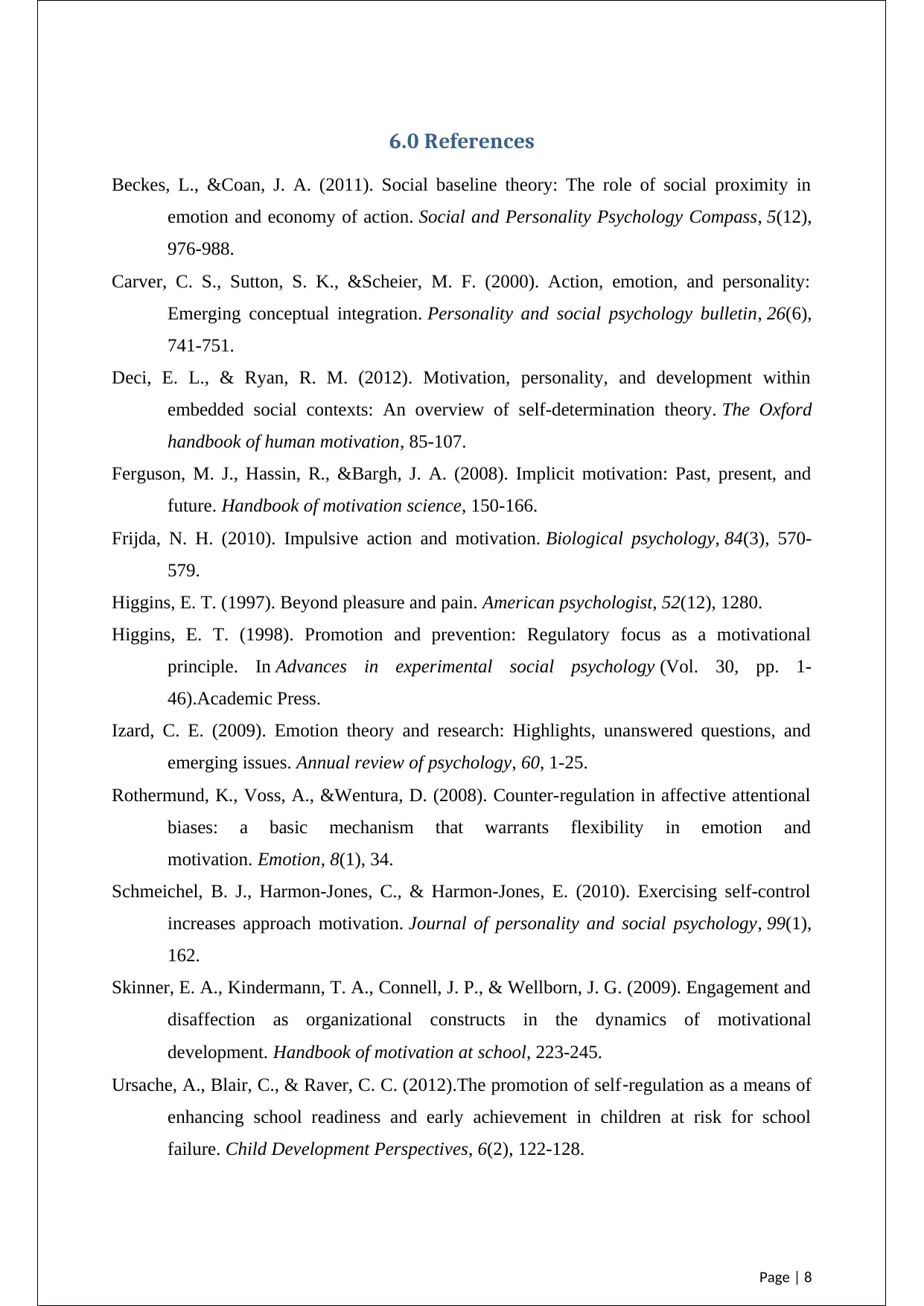
6.0 References
Beckes, L., &Coan, J. A. (2011). Social baseline theory: The role of social proximity in
emotion and economy of action. Social and Personality Psychology Compass, 5(12),
976-988.
Carver, C. S., Sutton, S. K., &Scheier, M. F. (2000). Action, emotion, and personality:
Emerging conceptual integration. Personality and social psychology bulletin, 26(6),
741-751.
Deci, E. L., & Ryan, R. M. (2012). Motivation, personality, and development within
embedded social contexts: An overview of self-determination theory. The Oxford
handbook of human motivation, 85-107.
Ferguson, M. J., Hassin, R., &Bargh, J. A. (2008). Implicit motivation: Past, present, and
future. Handbook of motivation science, 150-166.
Frijda, N. H. (2010). Impulsive action and motivation. Biological psychology, 84(3), 570-
579.
Higgins, E. T. (1997). Beyond pleasure and pain. American psychologist, 52(12), 1280.
Higgins, E. T. (1998). Promotion and prevention: Regulatory focus as a motivational
principle. In Advances in experimental social psychology (Vol. 30, pp. 1-
46).Academic Press.
Izard, C. E. (2009). Emotion theory and research: Highlights, unanswered questions, and
emerging issues. Annual review of psychology, 60, 1-25.
Rothermund, K., Voss, A., &Wentura, D. (2008). Counter-regulation in affective attentional
biases: a basic mechanism that warrants flexibility in emotion and
motivation. Emotion, 8(1), 34.
Schmeichel, B. J., Harmon-Jones, C., & Harmon-Jones, E. (2010). Exercising self-control
increases approach motivation. Journal of personality and social psychology, 99(1),
162.
Skinner, E. A., Kindermann, T. A., Connell, J. P., & Wellborn, J. G. (2009). Engagement and
disaffection as organizational constructs in the dynamics of motivational
development. Handbook of motivation at school, 223-245.
Ursache, A., Blair, C., & Raver, C. C. (2012).The promotion of self‐regulation as a means of
enhancing school readiness and early achievement in children at risk for school
failure. Child Development Perspectives, 6(2), 122-128.
Page | 8
Beckes, L., &Coan, J. A. (2011). Social baseline theory: The role of social proximity in
emotion and economy of action. Social and Personality Psychology Compass, 5(12),
976-988.
Carver, C. S., Sutton, S. K., &Scheier, M. F. (2000). Action, emotion, and personality:
Emerging conceptual integration. Personality and social psychology bulletin, 26(6),
741-751.
Deci, E. L., & Ryan, R. M. (2012). Motivation, personality, and development within
embedded social contexts: An overview of self-determination theory. The Oxford
handbook of human motivation, 85-107.
Ferguson, M. J., Hassin, R., &Bargh, J. A. (2008). Implicit motivation: Past, present, and
future. Handbook of motivation science, 150-166.
Frijda, N. H. (2010). Impulsive action and motivation. Biological psychology, 84(3), 570-
579.
Higgins, E. T. (1997). Beyond pleasure and pain. American psychologist, 52(12), 1280.
Higgins, E. T. (1998). Promotion and prevention: Regulatory focus as a motivational
principle. In Advances in experimental social psychology (Vol. 30, pp. 1-
46).Academic Press.
Izard, C. E. (2009). Emotion theory and research: Highlights, unanswered questions, and
emerging issues. Annual review of psychology, 60, 1-25.
Rothermund, K., Voss, A., &Wentura, D. (2008). Counter-regulation in affective attentional
biases: a basic mechanism that warrants flexibility in emotion and
motivation. Emotion, 8(1), 34.
Schmeichel, B. J., Harmon-Jones, C., & Harmon-Jones, E. (2010). Exercising self-control
increases approach motivation. Journal of personality and social psychology, 99(1),
162.
Skinner, E. A., Kindermann, T. A., Connell, J. P., & Wellborn, J. G. (2009). Engagement and
disaffection as organizational constructs in the dynamics of motivational
development. Handbook of motivation at school, 223-245.
Ursache, A., Blair, C., & Raver, C. C. (2012).The promotion of self‐regulation as a means of
enhancing school readiness and early achievement in children at risk for school
failure. Child Development Perspectives, 6(2), 122-128.
Page | 8
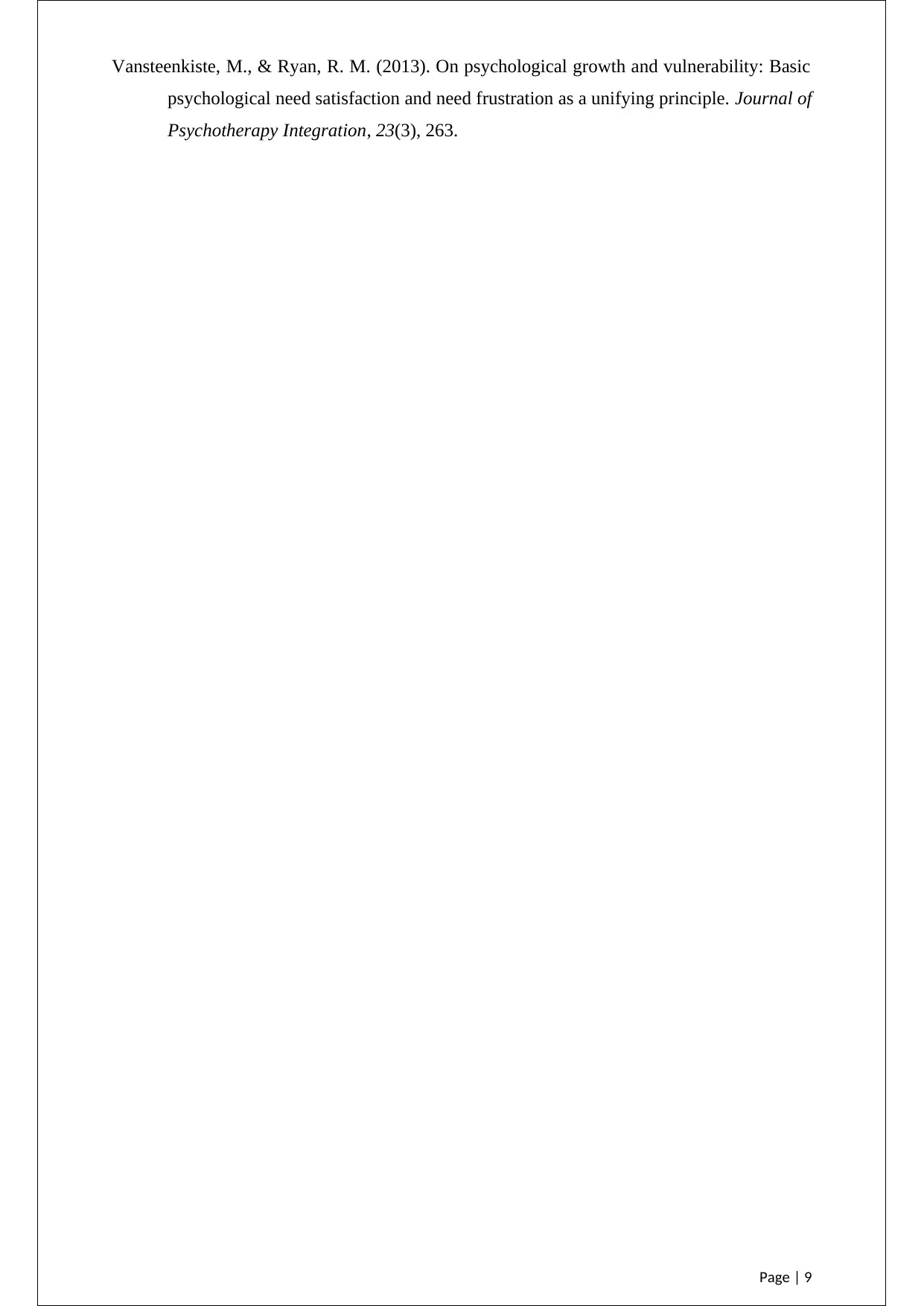
Vansteenkiste, M., & Ryan, R. M. (2013). On psychological growth and vulnerability: Basic
psychological need satisfaction and need frustration as a unifying principle. Journal of
Psychotherapy Integration, 23(3), 263.
Page | 9
psychological need satisfaction and need frustration as a unifying principle. Journal of
Psychotherapy Integration, 23(3), 263.
Page | 9
⊘ This is a preview!⊘
Do you want full access?
Subscribe today to unlock all pages.

Trusted by 1+ million students worldwide

7.0 Appendix
Supplementary Materials
Table 1: Descriptive statistical measures for age
N Minimu
m
Maximu
m
Mean Std.
Deviation
Skewness Kurtosis
Statisti
c
Statistic Statistic Statisti
c
Statistic Statisti
c
Std.
Error
Statisti
c
Std.
Error
AGE 145 18 51 20.94 5.798 3.540 .201 12.824 .400
Valid N
(listwise) 145
Table 2: Descriptive statistical measures for three BAS scores and RTF score
N Minimum Maximum Mean Std. Deviation Skewness
Statistic Statistic Statistic Statistic Statistic Statistic
BAS DRIVE 145 1.00 4.00 2.7138 .56595 -.124
BAS FUN SEEKING 145 1.50 4.00 3.0000 .54645 -.218
BAS REWARD
RESPNOSIVENESS 145 3.00 5.00 4.2638 .48123 -.298
REGULATION FOCUS
PROMOTION 145 2.1667 4.1667 3.242529 .3568008 .011
Valid N (listwise) 145
Descriptive Statistics
Skewness Kurtosis
Std. Error Statistic Std. Error
BAS DRIVE .201 .040 .400
BAS FUN SEEKING .201 -.272 .400
BAS REWARD REPOSIVENESS .201 -.391 .400
REGULATION FOCUS PROMOTION .201 -.109 .400
Valid N (listwise)
Page | 10
Supplementary Materials
Table 1: Descriptive statistical measures for age
N Minimu
m
Maximu
m
Mean Std.
Deviation
Skewness Kurtosis
Statisti
c
Statistic Statistic Statisti
c
Statistic Statisti
c
Std.
Error
Statisti
c
Std.
Error
AGE 145 18 51 20.94 5.798 3.540 .201 12.824 .400
Valid N
(listwise) 145
Table 2: Descriptive statistical measures for three BAS scores and RTF score
N Minimum Maximum Mean Std. Deviation Skewness
Statistic Statistic Statistic Statistic Statistic Statistic
BAS DRIVE 145 1.00 4.00 2.7138 .56595 -.124
BAS FUN SEEKING 145 1.50 4.00 3.0000 .54645 -.218
BAS REWARD
RESPNOSIVENESS 145 3.00 5.00 4.2638 .48123 -.298
REGULATION FOCUS
PROMOTION 145 2.1667 4.1667 3.242529 .3568008 .011
Valid N (listwise) 145
Descriptive Statistics
Skewness Kurtosis
Std. Error Statistic Std. Error
BAS DRIVE .201 .040 .400
BAS FUN SEEKING .201 -.272 .400
BAS REWARD REPOSIVENESS .201 -.391 .400
REGULATION FOCUS PROMOTION .201 -.109 .400
Valid N (listwise)
Page | 10
Paraphrase This Document
Need a fresh take? Get an instant paraphrase of this document with our AI Paraphraser
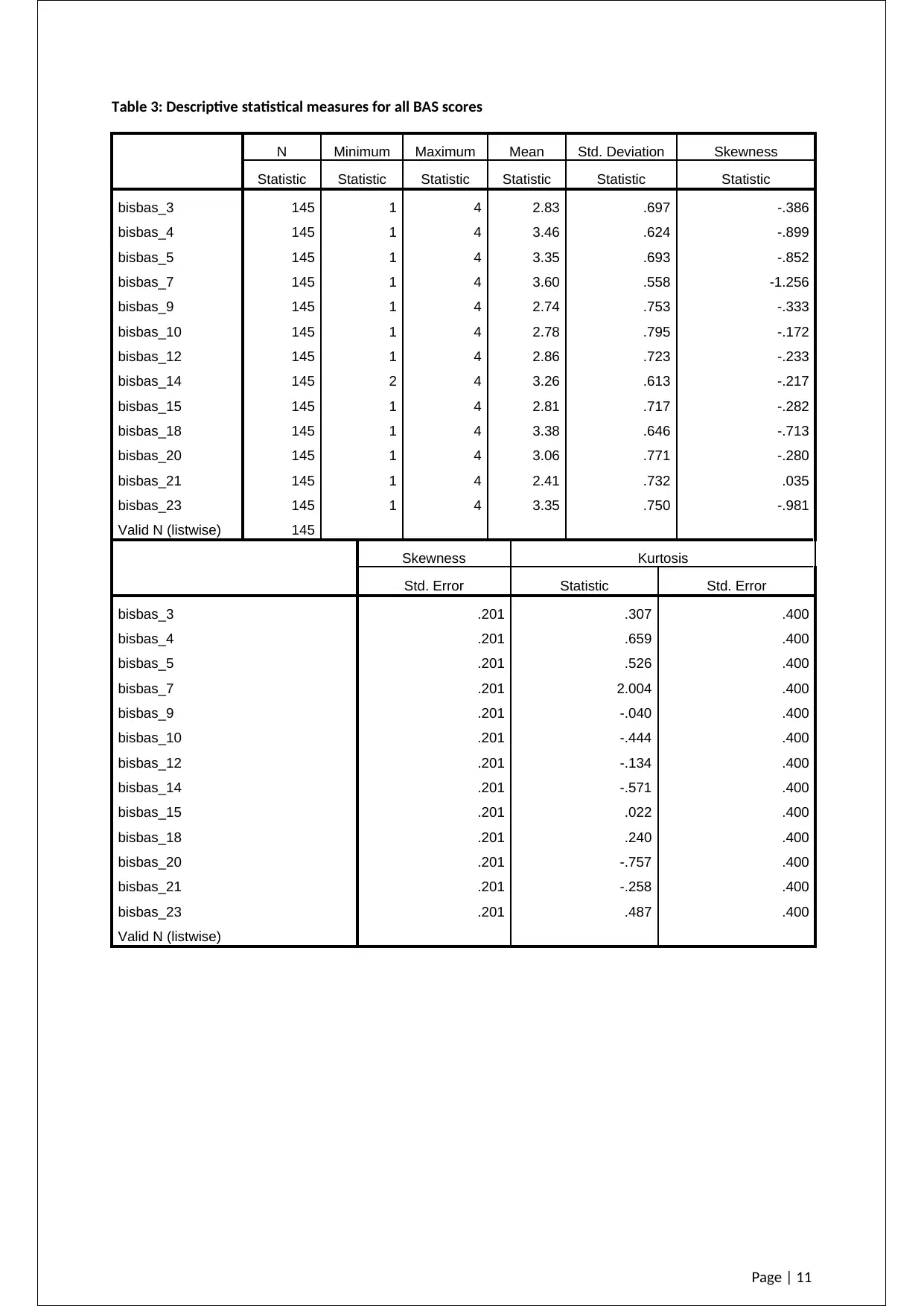
Table 3: Descriptive statistical measures for all BAS scores
N Minimum Maximum Mean Std. Deviation Skewness
Statistic Statistic Statistic Statistic Statistic Statistic
bisbas_3 145 1 4 2.83 .697 -.386
bisbas_4 145 1 4 3.46 .624 -.899
bisbas_5 145 1 4 3.35 .693 -.852
bisbas_7 145 1 4 3.60 .558 -1.256
bisbas_9 145 1 4 2.74 .753 -.333
bisbas_10 145 1 4 2.78 .795 -.172
bisbas_12 145 1 4 2.86 .723 -.233
bisbas_14 145 2 4 3.26 .613 -.217
bisbas_15 145 1 4 2.81 .717 -.282
bisbas_18 145 1 4 3.38 .646 -.713
bisbas_20 145 1 4 3.06 .771 -.280
bisbas_21 145 1 4 2.41 .732 .035
bisbas_23 145 1 4 3.35 .750 -.981
Valid N (listwise) 145
Skewness Kurtosis
Std. Error Statistic Std. Error
bisbas_3 .201 .307 .400
bisbas_4 .201 .659 .400
bisbas_5 .201 .526 .400
bisbas_7 .201 2.004 .400
bisbas_9 .201 -.040 .400
bisbas_10 .201 -.444 .400
bisbas_12 .201 -.134 .400
bisbas_14 .201 -.571 .400
bisbas_15 .201 .022 .400
bisbas_18 .201 .240 .400
bisbas_20 .201 -.757 .400
bisbas_21 .201 -.258 .400
bisbas_23 .201 .487 .400
Valid N (listwise)
Page | 11
N Minimum Maximum Mean Std. Deviation Skewness
Statistic Statistic Statistic Statistic Statistic Statistic
bisbas_3 145 1 4 2.83 .697 -.386
bisbas_4 145 1 4 3.46 .624 -.899
bisbas_5 145 1 4 3.35 .693 -.852
bisbas_7 145 1 4 3.60 .558 -1.256
bisbas_9 145 1 4 2.74 .753 -.333
bisbas_10 145 1 4 2.78 .795 -.172
bisbas_12 145 1 4 2.86 .723 -.233
bisbas_14 145 2 4 3.26 .613 -.217
bisbas_15 145 1 4 2.81 .717 -.282
bisbas_18 145 1 4 3.38 .646 -.713
bisbas_20 145 1 4 3.06 .771 -.280
bisbas_21 145 1 4 2.41 .732 .035
bisbas_23 145 1 4 3.35 .750 -.981
Valid N (listwise) 145
Skewness Kurtosis
Std. Error Statistic Std. Error
bisbas_3 .201 .307 .400
bisbas_4 .201 .659 .400
bisbas_5 .201 .526 .400
bisbas_7 .201 2.004 .400
bisbas_9 .201 -.040 .400
bisbas_10 .201 -.444 .400
bisbas_12 .201 -.134 .400
bisbas_14 .201 -.571 .400
bisbas_15 .201 .022 .400
bisbas_18 .201 .240 .400
bisbas_20 .201 -.757 .400
bisbas_21 .201 -.258 .400
bisbas_23 .201 .487 .400
Valid N (listwise)
Page | 11
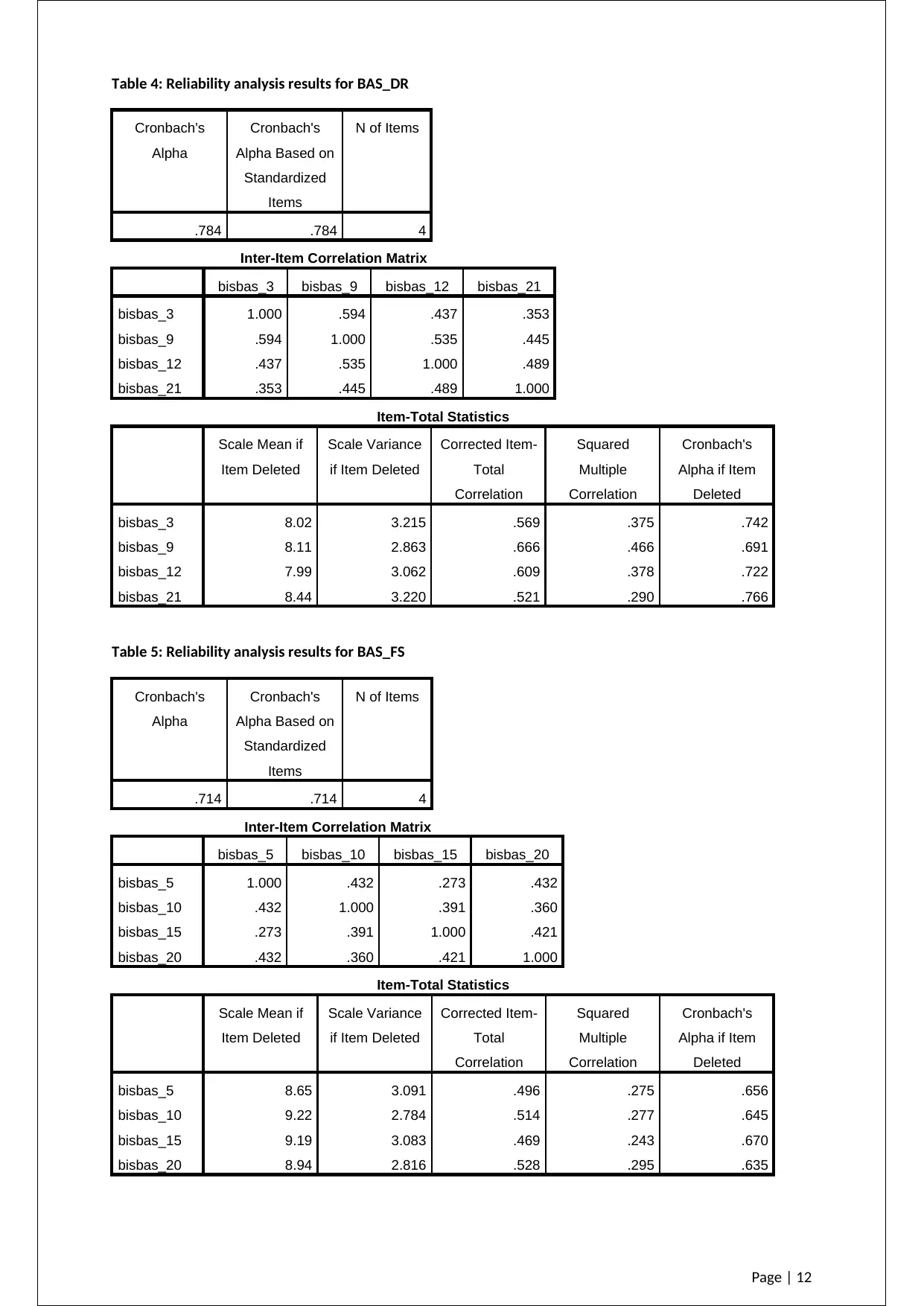
Table 4: Reliability analysis results for BAS_DR
Cronbach's
Alpha
Cronbach's
Alpha Based on
Standardized
Items
N of Items
.784 .784 4
Inter-Item Correlation Matrix
bisbas_3 bisbas_9 bisbas_12 bisbas_21
bisbas_3 1.000 .594 .437 .353
bisbas_9 .594 1.000 .535 .445
bisbas_12 .437 .535 1.000 .489
bisbas_21 .353 .445 .489 1.000
Item-Total Statistics
Scale Mean if
Item Deleted
Scale Variance
if Item Deleted
Corrected Item-
Total
Correlation
Squared
Multiple
Correlation
Cronbach's
Alpha if Item
Deleted
bisbas_3 8.02 3.215 .569 .375 .742
bisbas_9 8.11 2.863 .666 .466 .691
bisbas_12 7.99 3.062 .609 .378 .722
bisbas_21 8.44 3.220 .521 .290 .766
Table 5: Reliability analysis results for BAS_FS
Cronbach's
Alpha
Cronbach's
Alpha Based on
Standardized
Items
N of Items
.714 .714 4
Inter-Item Correlation Matrix
bisbas_5 bisbas_10 bisbas_15 bisbas_20
bisbas_5 1.000 .432 .273 .432
bisbas_10 .432 1.000 .391 .360
bisbas_15 .273 .391 1.000 .421
bisbas_20 .432 .360 .421 1.000
Item-Total Statistics
Scale Mean if
Item Deleted
Scale Variance
if Item Deleted
Corrected Item-
Total
Correlation
Squared
Multiple
Correlation
Cronbach's
Alpha if Item
Deleted
bisbas_5 8.65 3.091 .496 .275 .656
bisbas_10 9.22 2.784 .514 .277 .645
bisbas_15 9.19 3.083 .469 .243 .670
bisbas_20 8.94 2.816 .528 .295 .635
Page | 12
Cronbach's
Alpha
Cronbach's
Alpha Based on
Standardized
Items
N of Items
.784 .784 4
Inter-Item Correlation Matrix
bisbas_3 bisbas_9 bisbas_12 bisbas_21
bisbas_3 1.000 .594 .437 .353
bisbas_9 .594 1.000 .535 .445
bisbas_12 .437 .535 1.000 .489
bisbas_21 .353 .445 .489 1.000
Item-Total Statistics
Scale Mean if
Item Deleted
Scale Variance
if Item Deleted
Corrected Item-
Total
Correlation
Squared
Multiple
Correlation
Cronbach's
Alpha if Item
Deleted
bisbas_3 8.02 3.215 .569 .375 .742
bisbas_9 8.11 2.863 .666 .466 .691
bisbas_12 7.99 3.062 .609 .378 .722
bisbas_21 8.44 3.220 .521 .290 .766
Table 5: Reliability analysis results for BAS_FS
Cronbach's
Alpha
Cronbach's
Alpha Based on
Standardized
Items
N of Items
.714 .714 4
Inter-Item Correlation Matrix
bisbas_5 bisbas_10 bisbas_15 bisbas_20
bisbas_5 1.000 .432 .273 .432
bisbas_10 .432 1.000 .391 .360
bisbas_15 .273 .391 1.000 .421
bisbas_20 .432 .360 .421 1.000
Item-Total Statistics
Scale Mean if
Item Deleted
Scale Variance
if Item Deleted
Corrected Item-
Total
Correlation
Squared
Multiple
Correlation
Cronbach's
Alpha if Item
Deleted
bisbas_5 8.65 3.091 .496 .275 .656
bisbas_10 9.22 2.784 .514 .277 .645
bisbas_15 9.19 3.083 .469 .243 .670
bisbas_20 8.94 2.816 .528 .295 .635
Page | 12
⊘ This is a preview!⊘
Do you want full access?
Subscribe today to unlock all pages.

Trusted by 1+ million students worldwide
1 out of 16
Related Documents
Your All-in-One AI-Powered Toolkit for Academic Success.
+13062052269
info@desklib.com
Available 24*7 on WhatsApp / Email
![[object Object]](/_next/static/media/star-bottom.7253800d.svg)
Unlock your academic potential
Copyright © 2020–2025 A2Z Services. All Rights Reserved. Developed and managed by ZUCOL.




